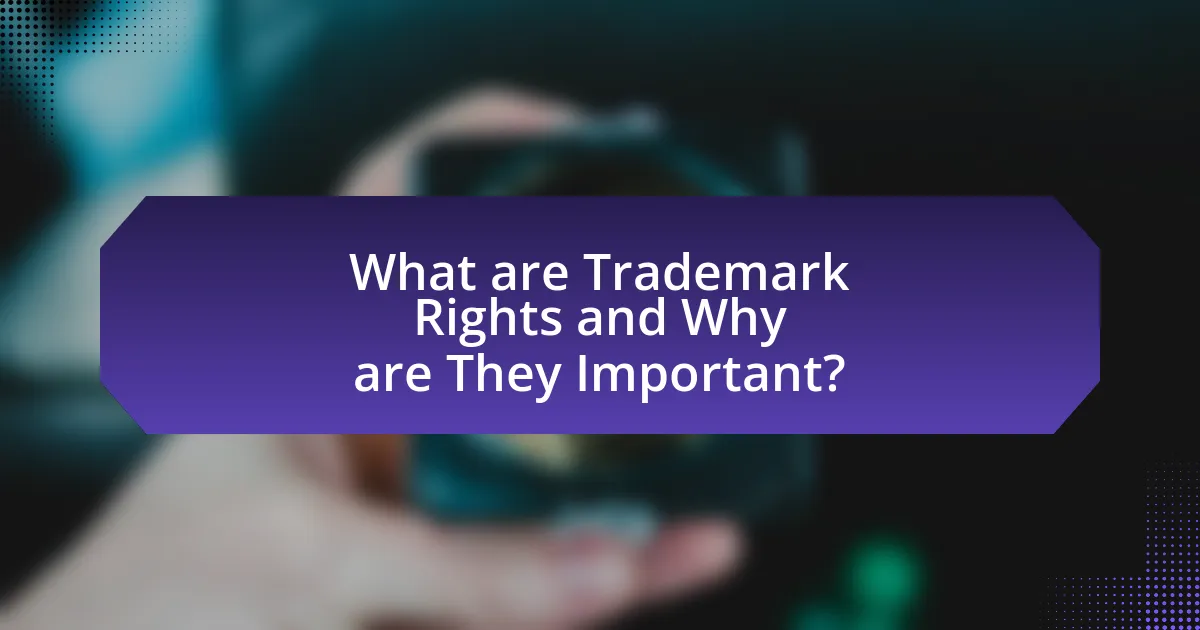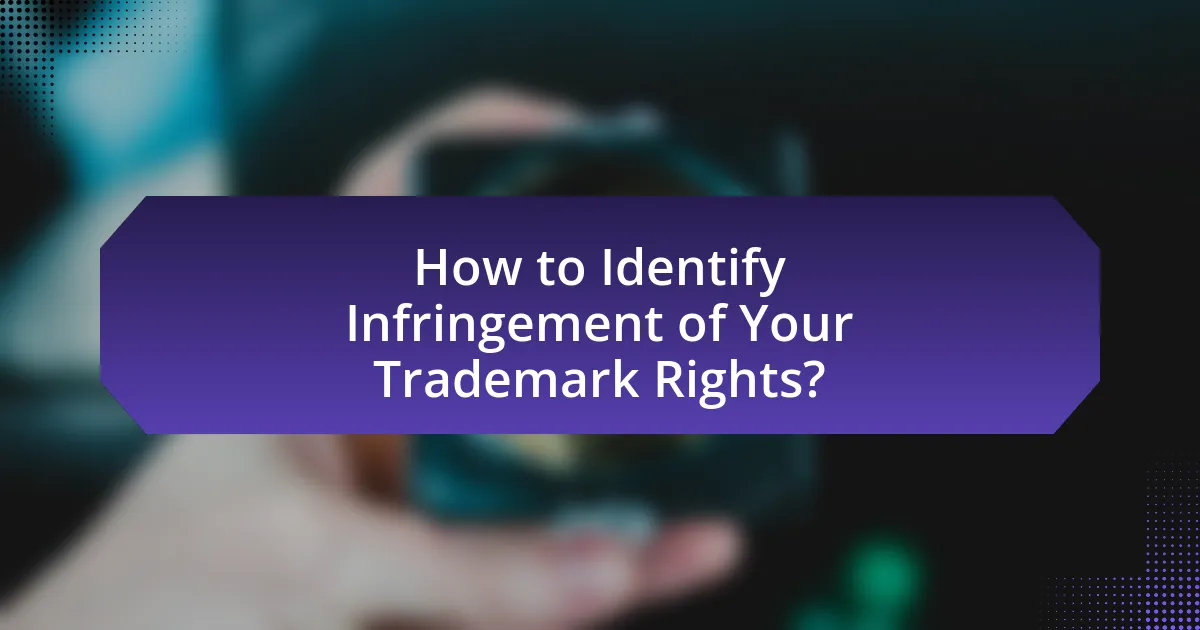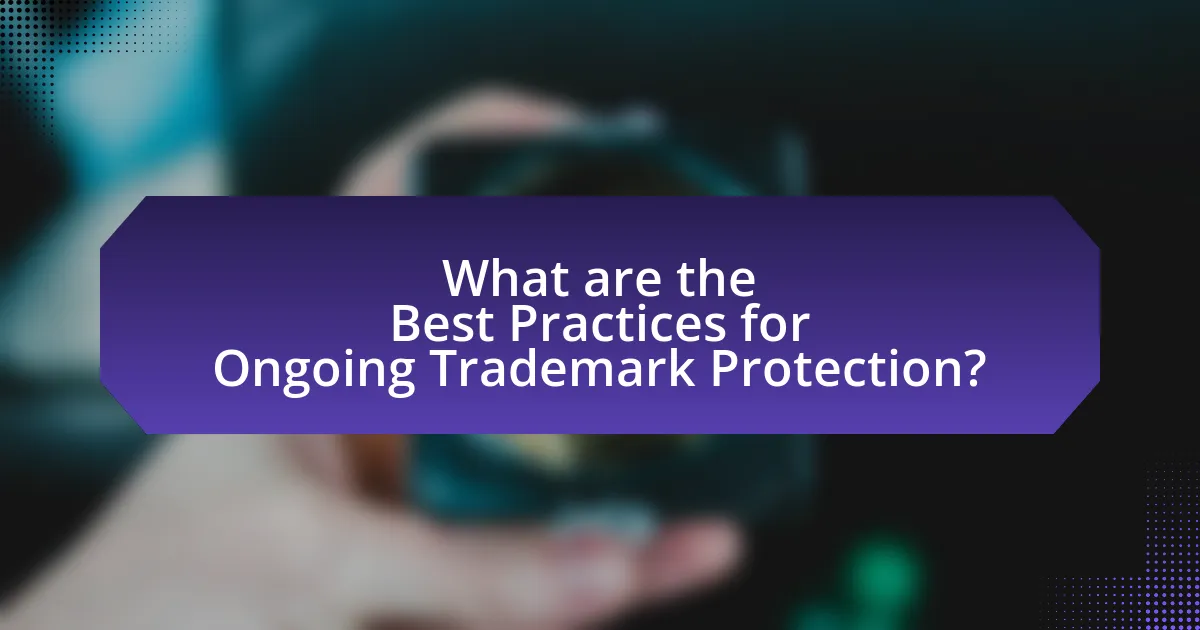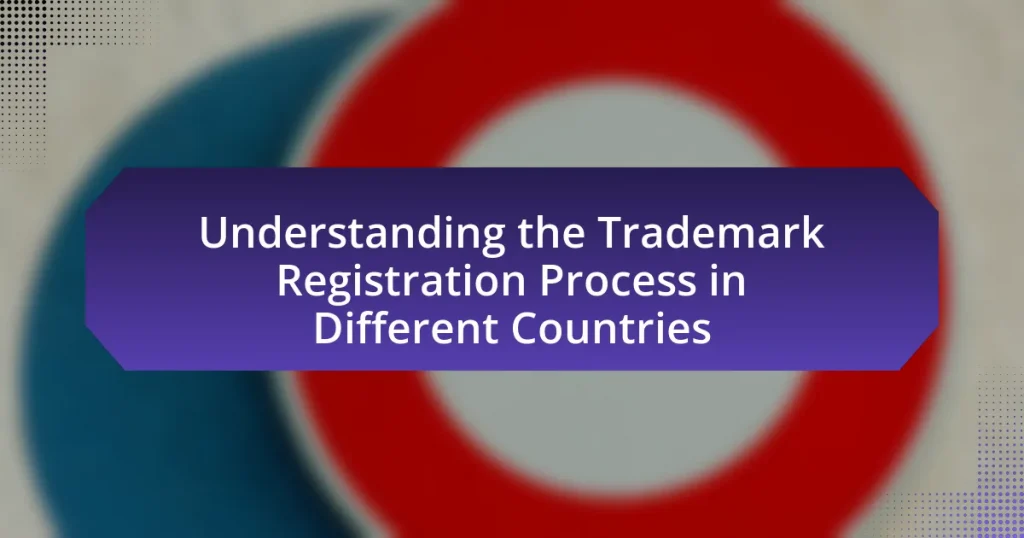Trademark rights are essential legal protections for distinctive signs, symbols, or names that identify and differentiate goods or services in the marketplace. This article outlines the importance of trademark rights in preventing consumer confusion, protecting brand reputation, and providing competitive advantages. It details how businesses can protect their trademarks, the types of trademarks eligible for protection, and the consequences of failing to enforce these rights. Additionally, the article discusses methods for identifying trademark infringement, best practices for ongoing protection, and the role of legal professionals in enforcing trademark rights effectively. Key strategies for monitoring, assessing infringement severity, and taking legal action are also highlighted to ensure trademark owners maintain their intellectual property rights.

What are Trademark Rights and Why are They Important?
Trademark rights are legal protections granted to the owners of distinctive signs, symbols, or names that identify and distinguish their goods or services from those of others. These rights are important because they help prevent consumer confusion, protect brand reputation, and provide a competitive advantage in the marketplace. For instance, according to the United States Patent and Trademark Office, registered trademarks can enhance the value of a business by establishing brand recognition and loyalty, which can lead to increased sales and market share.
How do Trademark Rights protect businesses?
Trademark rights protect businesses by granting them exclusive use of their brand identifiers, such as names, logos, and slogans. This exclusivity prevents others from using similar marks that could confuse consumers, thereby safeguarding the business’s reputation and market position. For instance, a study by the International Trademark Association indicates that businesses with registered trademarks experience a 20% increase in brand recognition compared to those without. This legal protection not only deters infringement but also allows businesses to take legal action against unauthorized use, ensuring their intellectual property remains distinct and valuable.
What types of trademarks can be protected?
Trademarks that can be protected include standard character marks, design marks, service marks, collective marks, and certification marks. Standard character marks protect words, letters, numbers, or any combination thereof without regard to font, style, size, or color. Design marks protect logos or symbols that represent a brand. Service marks are similar to trademarks but specifically identify services rather than goods. Collective marks are used by members of a collective group or organization to identify their goods or services, while certification marks indicate that goods or services meet certain standards. The U.S. Patent and Trademark Office recognizes these categories, providing legal protection to prevent unauthorized use and maintain brand integrity.
How do trademark rights differ from other intellectual property rights?
Trademark rights differ from other intellectual property rights primarily in their focus on brand identity and consumer recognition. Unlike patents, which protect inventions and processes for a limited time, or copyrights, which safeguard original works of authorship, trademarks are designed to distinguish goods or services of one entity from those of others, thereby preventing consumer confusion. For instance, the Lanham Act in the United States establishes the legal framework for trademark protection, emphasizing the importance of brand reputation and consumer trust. This unique aspect of trademarks highlights their role in commerce, where the value lies in the association between a brand and its quality, rather than in the creation of a novel product or artistic expression.
What are the consequences of not enforcing trademark rights?
Not enforcing trademark rights can lead to significant consequences, including the loss of exclusive rights to the trademark and increased risk of brand dilution. When a trademark owner fails to take action against infringers, they may inadvertently allow others to use the mark, which can weaken its distinctiveness and value. This is supported by the principle that trademarks must be actively defended to maintain their legal protections; failure to do so can result in a loss of rights under the doctrine of “abandonment.” Additionally, not enforcing trademark rights can lead to confusion among consumers, potentially harming the brand’s reputation and market position.
How can failing to enforce trademark rights lead to loss of protection?
Failing to enforce trademark rights can lead to loss of protection because it may result in the trademark becoming vulnerable to dilution or abandonment. When a trademark owner does not actively monitor and challenge unauthorized use, it signals to the public that the trademark is not being defended, which can weaken its distinctiveness. Legal precedents, such as the case of “McCarthy on Trademarks,” indicate that consistent enforcement is crucial; otherwise, a trademark may lose its exclusive rights if it becomes generic or if the owner is perceived as not caring about the mark’s integrity. This lack of enforcement can ultimately lead to competitors using similar marks without consequence, eroding the original trademark’s value and legal standing.
What are the potential financial impacts of trademark infringement?
Trademark infringement can lead to significant financial impacts, including loss of revenue, legal costs, and damage to brand reputation. Businesses may experience decreased sales due to consumer confusion, as customers may choose the infringing product over the original brand. Legal expenses can accumulate quickly, with costs associated with litigation, attorney fees, and potential settlements or damages awarded to the trademark owner. Additionally, a tarnished brand reputation can result in long-term financial consequences, as consumers may lose trust in the brand, leading to reduced market share and profitability. According to a study by the International Trademark Association, trademark infringement can cost businesses millions in lost sales and legal fees, underscoring the importance of enforcing trademark rights effectively.

How to Identify Infringement of Your Trademark Rights?
To identify infringement of your trademark rights, monitor the marketplace for unauthorized use of your trademark. This includes regularly searching online platforms, social media, and physical stores for similar marks that could cause confusion among consumers. Legal standards, such as the likelihood of confusion test, help determine if an infringement has occurred, which considers factors like the similarity of the marks, the relatedness of the goods or services, and the channels of trade. Additionally, utilizing trademark watch services can provide alerts for potential infringements, ensuring proactive protection of your rights.
What signs indicate potential trademark infringement?
Signs that indicate potential trademark infringement include the use of a mark that is confusingly similar to an existing trademark, particularly in the same or related goods or services. This similarity can lead to consumer confusion regarding the source of the products or services. Additional signs include the unauthorized use of a trademark in advertising or promotional materials, as well as instances where consumers mistakenly attribute the origin of goods or services to the trademark owner due to the infringing party’s actions. Legal precedents, such as the Polaroid factors used in the United States, further outline criteria for assessing likelihood of confusion, reinforcing the importance of these signs in identifying potential infringement.
How can you monitor the market for trademark violations?
To monitor the market for trademark violations, businesses can employ a combination of automated monitoring tools, regular market surveillance, and legal resources. Automated monitoring tools, such as trademark watch services, can track new trademark registrations and alert businesses to potential conflicts. Regular market surveillance involves actively searching online marketplaces, social media platforms, and industry publications for unauthorized use of trademarks. Legal resources, including consulting with intellectual property attorneys, can provide guidance on identifying and addressing violations. According to a report by the International Trademark Association, proactive monitoring is essential for maintaining trademark rights and preventing dilution, as it allows businesses to act swiftly against infringers.
What tools and resources are available for trademark monitoring?
Trademark monitoring tools and resources include specialized software, databases, and services that track the use of trademarks across various platforms. Tools such as TrademarkNow and Corsearch provide comprehensive monitoring services that alert trademark owners to potential infringements by scanning global trademark databases and online marketplaces. Additionally, resources like the United States Patent and Trademark Office (USPTO) offer databases for trademark registration and status, while services like Watchdog and Markify provide ongoing monitoring and alerts for new filings that may conflict with existing trademarks. These tools are essential for maintaining trademark rights and ensuring timely action against potential infringements.
How do you assess the severity of trademark infringement?
To assess the severity of trademark infringement, one must evaluate factors such as the likelihood of confusion among consumers, the similarity between the marks, and the nature of the goods or services involved. The likelihood of confusion is determined by analyzing how similar the trademarks are and whether they are used in similar markets, which can lead to consumer misunderstanding. Courts often consider the strength of the original trademark, the intent of the infringer, and any evidence of actual confusion. For instance, a study by the International Trademark Association indicates that 75% of consumers mistakenly associate similar trademarks, highlighting the importance of these factors in assessing infringement severity.
What factors should be considered when evaluating infringement cases?
When evaluating infringement cases, key factors include the likelihood of confusion, the strength of the trademark, the similarity of the marks, and the nature of the goods or services involved. The likelihood of confusion assesses whether consumers might mistakenly believe that the goods or services come from the same source. The strength of the trademark refers to its distinctiveness and recognition in the marketplace, which can influence the case’s outcome. The similarity of the marks involves comparing visual, phonetic, and conceptual aspects to determine potential confusion. Lastly, the nature of the goods or services considers how closely related they are, as similar products are more likely to cause confusion among consumers. These factors are critical in establishing whether infringement has occurred and are supported by legal precedents in trademark law.
How does the likelihood of confusion affect infringement assessments?
The likelihood of confusion is a critical factor in infringement assessments, as it determines whether consumers are likely to mistakenly believe that two products or services come from the same source. Courts evaluate various elements, such as the similarity of the marks, the relatedness of the goods or services, and the channels of trade, to assess this likelihood. For instance, in the case of Polaroid Corp. v. Polarad Electronics Corp., the Second Circuit established a multi-factor test that has been widely adopted, emphasizing that a strong likelihood of confusion can lead to a finding of trademark infringement. This legal framework underscores the importance of consumer perception in trademark disputes, as a high likelihood of confusion can result in the protection of trademark rights and the prevention of market dilution.

What Steps Can You Take to Enforce Your Trademark Rights?
To enforce your trademark rights, you should first send a cease-and-desist letter to the infringing party, clearly stating your trademark rights and requesting them to stop their infringing activities. This step is crucial as it formally notifies the infringer of your rights and provides them an opportunity to rectify the situation without further legal action. Following this, if the infringement continues, you may file a complaint with the United States Patent and Trademark Office (USPTO) or pursue legal action in court, depending on the severity of the infringement. According to the USPTO, taking these steps can help protect your brand and prevent further unauthorized use of your trademark.
How should you approach a suspected infringer?
To approach a suspected infringer, initiate contact with a clear and professional communication outlining your concerns regarding the infringement. This communication should include specific details about the alleged infringement, such as the trademark in question and how it is being used without authorization. Providing evidence of your trademark rights, such as registration details and examples of the infringing use, strengthens your position. According to the United States Patent and Trademark Office, clear documentation of trademark ownership and usage is essential in resolving disputes effectively.
What are the best practices for sending a cease and desist letter?
The best practices for sending a cease and desist letter include clearly identifying the infringing party, stating the specific legal rights being violated, and providing a detailed description of the infringing activity. It is essential to use a professional tone and format, ensuring the letter is concise and free of emotional language. Additionally, including a deadline for compliance and outlining potential legal actions if the infringement continues can strengthen the letter’s effectiveness. According to legal experts, a well-structured cease and desist letter can often resolve disputes without the need for litigation, making it a crucial tool in enforcing trademark rights effectively.
How can negotiation lead to a resolution without litigation?
Negotiation can lead to a resolution without litigation by facilitating direct communication between parties to reach a mutually acceptable agreement. This process allows for flexibility in terms and conditions, enabling both sides to express their interests and concerns openly. For instance, studies show that approximately 70-90% of disputes are resolved through negotiation, highlighting its effectiveness as an alternative to court proceedings. By avoiding the costs and time associated with litigation, negotiation can provide a quicker and more satisfactory resolution for trademark disputes, preserving business relationships and allowing for creative solutions that a court may not impose.
When is it necessary to escalate to legal action?
It is necessary to escalate to legal action when attempts to resolve trademark disputes through negotiation or mediation fail. Legal action becomes essential if there is a clear infringement of trademark rights that threatens the brand’s integrity or market position. For instance, if a competitor uses a similar mark that causes consumer confusion and informal resolution efforts have not succeeded, pursuing legal remedies such as filing a lawsuit may be warranted. This approach is supported by the Lanham Act, which provides the legal framework for trademark protection in the United States, allowing trademark owners to seek damages and injunctions against infringers.
What are the steps involved in filing a trademark infringement lawsuit?
To file a trademark infringement lawsuit, the steps involved include conducting a thorough trademark search, gathering evidence of infringement, sending a cease-and-desist letter, filing a complaint in the appropriate court, serving the defendant, engaging in discovery, and ultimately going to trial if necessary.
Conducting a trademark search helps establish ownership and identify potential conflicts. Gathering evidence of infringement is crucial to support the claim, including documentation of the infringing use. A cease-and-desist letter serves as a formal notice to the infringer, often prompting resolution without litigation. Filing a complaint initiates the legal process, and serving the defendant ensures they are aware of the lawsuit. Discovery allows both parties to exchange information, which can clarify the case before trial. If the case does not settle, it proceeds to trial where a judge or jury will make a determination.
These steps are standard in trademark litigation, as outlined in legal resources such as the United States Patent and Trademark Office guidelines and various legal textbooks on intellectual property law.
How can you prepare for litigation to enforce your trademark rights?
To prepare for litigation to enforce your trademark rights, you should gather comprehensive evidence of your trademark use and any infringement. This includes collecting documentation such as registration certificates, marketing materials, sales records, and any communications regarding the infringement. Additionally, conducting a thorough investigation of the infringing party’s activities and their use of the trademark is crucial. This preparation is validated by the necessity of demonstrating the strength of your trademark and the likelihood of confusion in court, as established in cases like Polaroid Corp. v. Polarad Electronics Corp., which emphasizes the importance of evidence in trademark disputes.

What are the Best Practices for Ongoing Trademark Protection?
The best practices for ongoing trademark protection include regular monitoring of trademark use, timely renewal of registrations, and enforcement against infringement. Regular monitoring allows trademark owners to identify unauthorized use or potential conflicts, ensuring that their rights are not compromised. Timely renewal is crucial, as trademarks must be renewed periodically to maintain legal protection; for example, in the United States, trademarks need to be renewed every ten years. Enforcement against infringement involves taking legal action against unauthorized users to protect the brand’s integrity and prevent dilution. These practices are essential for maintaining the strength and value of a trademark in the marketplace.
How can you maintain and strengthen your trademark rights over time?
To maintain and strengthen trademark rights over time, consistently use the trademark in commerce and monitor its use by others. Regularly renewing the trademark registration is essential, as failure to do so can lead to loss of rights. Additionally, actively enforcing the trademark against unauthorized use helps to establish its distinctiveness and prevent dilution. According to the United States Patent and Trademark Office, trademarks must be used in a manner that demonstrates their source-identifying function, which reinforces the rights associated with the mark. Regularly conducting market surveys can also provide evidence of the trademark’s recognition and strength in the marketplace, further solidifying its legal standing.
What role does regular monitoring play in trademark enforcement?
Regular monitoring plays a crucial role in trademark enforcement by enabling trademark owners to detect unauthorized use of their marks promptly. This proactive approach allows businesses to identify potential infringements, such as counterfeiting or dilution, which can harm brand reputation and consumer trust. According to a study by the International Trademark Association, companies that engage in regular monitoring are 30% more likely to successfully enforce their trademark rights compared to those that do not. By consistently tracking the marketplace, trademark owners can take timely legal action, thereby safeguarding their intellectual property and maintaining their competitive edge.
How can you educate your team about trademark rights and enforcement?
To educate your team about trademark rights and enforcement, conduct comprehensive training sessions that cover the fundamentals of trademark law, including definitions, types of trademarks, and the importance of registration. These sessions should include real-world examples of trademark disputes and their resolutions, illustrating the consequences of infringement. Additionally, provide access to resources such as the United States Patent and Trademark Office (USPTO) guidelines and relevant case studies, which can enhance understanding and retention of the material. Regular updates on changes in trademark law and enforcement practices should also be shared to keep the team informed and compliant.
What resources are available for trademark owners?
Trademark owners have access to various resources, including legal databases, trademark registration services, and professional organizations. Legal databases, such as the United States Patent and Trademark Office (USPTO) database, provide essential information on existing trademarks and application processes. Trademark registration services assist owners in filing applications and navigating legal requirements, ensuring compliance with trademark laws. Additionally, professional organizations like the International Trademark Association (INTA) offer educational resources, networking opportunities, and advocacy for trademark rights, helping owners stay informed about best practices and legal developments in trademark enforcement.
How can legal professionals assist in enforcing trademark rights?
Legal professionals assist in enforcing trademark rights by providing legal advice, conducting trademark searches, and representing clients in disputes. They help clients understand the scope of their trademark rights and the legal frameworks that protect them. Additionally, legal professionals can draft and send cease-and-desist letters to infringers, file lawsuits to protect trademarks, and negotiate settlements. Their expertise ensures that trademark owners can effectively navigate the complexities of intellectual property law, thereby enhancing the protection of their brand assets.
What organizations provide support for trademark owners?
Organizations that provide support for trademark owners include the United States Patent and Trademark Office (USPTO), the International Trademark Association (INTA), and the World Intellectual Property Organization (WIPO). The USPTO offers resources for trademark registration and enforcement, while INTA provides advocacy, education, and networking opportunities for trademark professionals. WIPO facilitates international trademark protection and dispute resolution. These organizations play crucial roles in helping trademark owners navigate legal frameworks and protect their intellectual property rights effectively.
What are the common pitfalls to avoid in trademark enforcement?
Common pitfalls to avoid in trademark enforcement include failing to monitor the market for potential infringements, not taking timely action against violations, and neglecting to maintain proper trademark registrations. Monitoring is crucial because unaddressed infringements can weaken trademark rights; for instance, a study by the International Trademark Association indicates that proactive monitoring can significantly reduce instances of infringement. Timely action is essential, as delays can lead to a loss of rights or a perception of abandonment. Additionally, maintaining proper registrations ensures that trademarks remain enforceable; according to the United States Patent and Trademark Office, failure to renew registrations can result in loss of trademark protection.
How can you prevent unintentional abandonment of your trademark rights?
To prevent unintentional abandonment of trademark rights, consistently use the trademark in commerce and monitor its usage. Regularly applying the trademark in goods or services reinforces its active status, as non-use for three consecutive years can lead to abandonment under U.S. law. Additionally, conducting periodic audits of trademark registrations and usage helps identify any lapses or potential issues. According to the United States Patent and Trademark Office, maintaining proper records of use and filing necessary renewals every ten years is crucial to uphold trademark rights.
What mistakes should you avoid when dealing with infringers?
When dealing with infringers, you should avoid making threats without legal backing. This mistake can undermine your credibility and may lead to legal repercussions. Instead, it is crucial to gather evidence of the infringement and consult with a legal professional to determine the appropriate course of action. Failing to document the infringement can weaken your position in any potential legal dispute. Additionally, overlooking the importance of timely action can result in loss of trademark rights, as delays may be interpreted as acceptance of the infringement.



